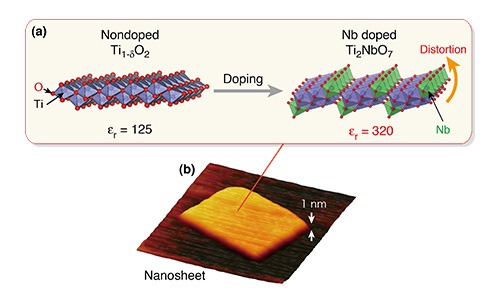- ホーム
- > 研究活動
- > Research Highlights
- > Vol. 2 High-performance thin film boo・・・
 Research Highlights
Research Highlights
[Vol. 2]
High-performance thin film boost for electronics research
MANA researchers have developed the world's highest performance thin-film capacitors using a new high-permittivity (high-κ) dielectric sheet with molecular-level thickness (~1 nm). This technology may revolutionize the next-generation electronics.

Figure : Tailor-made dielectric nanosheet via controlled nanoscale doping. (a) Structural change induced by Nb doping. (b) AFM image of titanium-niobate nanosheet.
The announcement of this breakthrough comes from a research group led by MANA Scientist Dr. Minoru Osada and Principal Investigator Dr. Takayoshi Sasaki of the International Center for Materials Nanoarchitectonics (MANA) at the National Institute for Material Science (NIMS) in Japan.
Good insulating, high-κ nanofilms are expected to be key to future applications as predicted by the International Technology Roadmap for Semiconductors (ITRS).
Minoru Osada and colleagues created thin films based on titanium-niobate nanosheets (TiNbO5, Ti2NbO7, Ti5NbO14) as building blocks. The research group delaminated layered oxides and stacked sheets on an atomically flat SrRuO3 substrate, creating films between 5 and 15 nm thick. The thin-film capacitors developed by this method have excellent dielectric characteristics, achieving the world's highest performance permittivity (160 ~ 300) with a film thickness of 5 ~ 15 nm.
The researchers relate the dielectric performance of the nanofilms to the structural features. In these nanosheets, the octahedral distortion inherent to site engineering by Nb doping results in a giant molecular polarizability. New cooperative functions that originate from the mutual interactions between nanoscale structural units comprise the focus of nanoarchitectonics, the discipline at the center of MANA research.
This latest research demonstrates simultaneous improvements in a number of material properties, including relative permittivity, lower loss and leakage current. The authors add, “The solution-based room-temperature process using oxide nanosheets as building blocks opens multiple possibilities for the development of high-κ dielectrics in capacitor technology, gate insulators in organic field effect transistors, energy-storage devices, and also future flexible electronics.”
Reference
"Controlled Polarizability of One-Nanometer-Thick Oxide Nanosheets for Tailored, High-κ Nanodielectrics"
Minoru Osada, Genki Takanashi, Bao-Wen Li, Kosho Akatsuka, Yasuo Ebina , Kanta Ono, Hiroshi Funakubo, Kazunori Takada, and Takayoshi Sasaki
Journal: Advanced Functional Materials. [26 July 2011]
DOI: 10.1002/adfm.201100580
Minoru Osada, Genki Takanashi, Bao-Wen Li, Kosho Akatsuka, Yasuo Ebina , Kanta Ono, Hiroshi Funakubo, Kazunori Takada, and Takayoshi Sasaki
Journal: Advanced Functional Materials. [26 July 2011]
DOI: 10.1002/adfm.201100580
Affiliations
International Center for Materials Nanoarchitectonics (WPI-MANA), National Institute for Materials Science (NIMS), Namiki 1-1, Tsukuba, Ibaraki 305-0044, Japan
Contact information
ナノアーキテクトニクス材料研究センター(MANA)
〒305-0044 茨城県つくば市並木1-1
TEL: 029-860-4710
E-mail: mana-pr=ml.nims.go.jp([ = ] → [ @ ] )
TEL: 029-860-4710
E-mail: mana-pr=ml.nims.go.jp([ = ] → [ @ ] )

